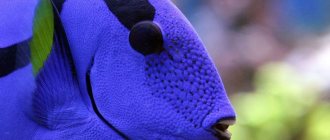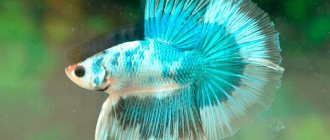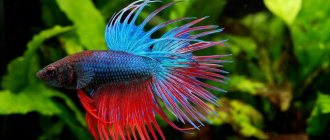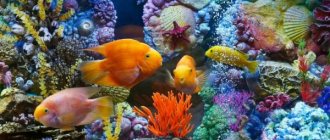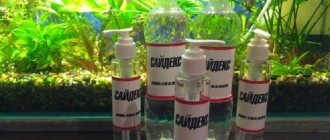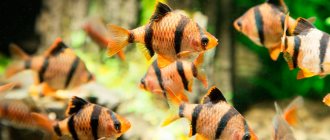5
(5)
Among all the diversity of underwater flora and fauna, it is difficult to single out any representatives. Each fish or plant has its own unique characteristics and appearance. However, some species deserve special attention because they look truly unusual and immediately catch the eye, even when other individuals are swimming nearby in the store. These include iris (also known as melanotenia).
Description
The size of irises in an aquarium is 5–16 cm (depending on the variety). The body shape of aquarium fish is flattened on the sides and slightly elongated. The anal fin is wide, and the dorsal fin is narrow, divided into two parts. The tail is forked. These handsome creatures with large eyes can boast of a variety of appearances: the body comes in different colors, and the fins are sometimes wonderfully shaped.
Melanothenia is also non-conflict. They are very peaceful and get along well with other calm inhabitants. They are active and love to swim throughout the water. They live 5-8 years in an aquarium.
They are also found in water bodies of Australia, New Guinea and Indonesia. Natural varieties are considered endangered.
Compatibility
You should not add predators and other aquarium fish with an aggressive disposition to them. Cichlids (astronotus, acara and others), goldfish - will be bad neighbors for rainbow fish.
Aquarium inhabitants suitable for iris:
- thorns;
- barbs;
- various catfish.
It should be remembered that rainbows love to be in the company of their own species.
Kinds
Most species of rainbow melanotenia that live in the aquarium were bred artificially. Thanks to selection, the fish received a fascinating appearance and bright color.
The following irises are popular.
Neon
The maximum length is 5 cm. It received its name for its characteristic color, due to which the scales shimmer with a neon blue color. Suitable for sharing with zebrafish and tetras.
Turquoise
The body of melanotenia is colored with a gradient from blue to greenish. The most beautiful representative of the species.
Parkinson's
A small fish, up to 11 cm in length. The color is steel-gray, with bright red spots on the sides.
Boesman
The color of the iris smoothly transitions from blue-violet to orange. Occurs naturally and is an endangered species. Males – 14 cm, females – up to 10.
Three stripe
Inhabitants of natural reservoirs. Various color options: golden, red, yellow and blue. A characteristic feature is horizontal stripes on the body.
The difference between rainbow trout and regular trout
Rainbow trout
Outwardly, mykiss is a little similar to ordinary sea trout; formally, it also belongs to the red fish, but in culinary terms it is very different in taste. Its flesh is a cross between salmon and river fish. The color is always paler than that of marine rocks, sometimes even without red tints.
The main differences between rainbow trout and sea trout:
| Differences | Marine | Rainbow |
| Carcass size | 3-5 kg | 1-2 kg |
| Flesh color | Mostly bright red or bright orange | Pale, sometimes almost white with a creamy tint |
| Scale size | Large scales | Smaller |
| Color of the skin | Silver, homogeneous | Two reddish stripes on the sides. Sometimes they shimmer in several colors |
Content
Rainbows are unpretentious. Recommended water parameters: temperature 22–28 degrees, acid-base balance neutral. Various water hardnesses are suitable.
Since the fish is playful and large, appropriate conditions are required. You cannot do without an aquarium with a volume of 50 liters or more, which will provide the fish with sufficient space for normal life. A lid over the surface of the aquarium is required, as there is a possibility that melanotenia will jump out of the vessel during games.
Rainbowfish are schooling fish, so they are stocked with 6, and ideally 8, individuals. Keeping and caring for fish includes:
- weekly water changes;
- establishing aeration;
- filtration;
- lighting that imitates natural light.
As well as the presence of driftwood, decorations and plants.
Feeding
Nutritional requirements are not specific. They consume plant, live and dry food. It is important to provide the iris with a balanced diet. The diet should contain animal and plant foods; you should not overuse dry food: if consumed excessively, dry food will cause diseases such as inflammation of the stomach and intestines. Live food includes bloodworms, tubifex, insects and some crustaceans.
At different times of the year, irisfishes change their feeding behavior. In their natural environment, rainbow fish distinguishes between two periods: the rainy season and the dry season. In dry times, fish eat plants, and in the rainy season they prefer animal food. This behavior is explained by the fact that during the rainy season more insects appear, and during the drought the fish need to consume more greens. This feature is often used for successful spawning.
Beneficial features
Mykizha contains many useful substances
Contains vitamins B, A, D, E. The composition contains elements important for health:
- Phosphorus
- Iron
- Zinc
- Selenium
- Magnesium
Omega-3 fatty acids are especially beneficial. Their content is less than in salmon, but they are easier to digest due to their optimal composition. Regular consumption of rainbow trout reduces cholesterol levels, strengthens blood vessels, and improves memory.
For the greatest benefit, it is recommended to eat mykiss with a side dish of steamed or baked vegetables with a minimum of oil. Ideal side dishes for rainbow trout include asparagus, carrots, celery and spinach greens.
Breeding
Sexual maturity in iridescents occurs between 6 and 12 months and depends on housing and feeding conditions. You can speed up the breeding season by increasing the water temperature by two degrees or by frequently changing the liquid.
1–2 weeks before breeding, females and males are kept separately from each other. Fish spawn both in a separate and in a common vessel, but it is better to give preference to a spawning aquarium. Future parents are placed there for a week.
Typically, females lay 350 eggs and do not eat their offspring. When spawning in a community aquarium, the eggs run the risk of being eaten by other fish species, so the babies need to be provided with shelter and increased vegetation while they mature.
To obtain higher quality offspring, it is customary to select the most colorful and healthy breeding fish. Individuals form pairs, and within a day spawning begins, which lasts for a week. If necessary, eggs should be placed in an incubator with similar water parameters every five days of spawning.
Iris fry acquire independence on the 5th–7th day of life. At the age of a month, the color of the young fish becomes bright and striking, and then it is possible to determine which sex the fish belongs to. It is recommended to feed with ciliates, live dust, special liquid and powder feeds for fry.
Young individuals need increased attention to filtration, oxygen supply and frequent water changes. The fry are extremely sensitive to sudden changes in temperature, so the necessary manipulations must be carried out smoothly.
Sea or river
The homeland of the iris is the Pacific basin of North America, where it was distributed from Mexican waters to Alaskan waters. Since 1874, its triumphal march (more precisely, sailing) began across all continents, with the exception of Antarctica. Aquaculture specialists have introduced it into all waters possible for its life as a fishery object.
In the 1950s, pelleted feed began to be produced, which contributed to the growth of trout farming. They began to catch and breed it in the mountainous catchments of subtropical countries in East Africa, Asia, South America, and cold-water fisheries in Norway, where today it is one of the most popular sport fishing objects. The fish can live in both warm and moderately cold water (it thrives in mountain lakes and rivers, where the water temperature is +14-20 ℃). This trout is not a sea fish, but a river fish.
In northern Russia, the iris was not released into natural bodies of water. Since the 1970s it is grown artificially:
- on the Kola Peninsula;
- in the Arkhangelsk region;
- in the Leningrad region;
- in Karelia (now 70% of the commercial iris that goes on store shelves is grown there in cages).
Ichthyological breeders are actively engaged in the selection and breeding of highly productive varieties. Today, these are considered to be a deep-sea variety of trout native to Canada - Kamloops - and Donaldson's trout. In the photo, a non-specialist will not be able to distinguish which one is which. But Donaldson's trout is the result of long selection - a fast-growing, highly productive form, characterized by great fertility. She was brought to us from Japan in 1988. An ordinary rainbow reaches a weight of 1 kg in two years, Donaldson's trout - in one and a half years.
It is curious that today this fish is bred exclusively artificially. If the fry are released into free swimming and they go to sea, then they will grow into trout, called brown trout, and if they end up living in streams, they will grow into brook pied fish.
Adviсe
- In aquariums, leave more space for rainbow fish, reducing the space allocated for greenery and decorations.
- If melanothenia eat aquarium plants, then their diet does not have enough plant food.
- For convenience, during spawning you can place plants with leaves or a sponge with cells in the aquarium, then the female will have a place where she can lay eggs.
- Spawning fish require observation. In rare cases, the eggs are eaten by the parents.
- Nutrition must be carefully monitored, especially during spawning. The amount of food should be increased during the spawning period, but the fish should not be overfed. The best food for the parents would be live food due to its high protein content.
- If the color of the fish fades, then it does not have enough free space.
- Once a week, the fish are given a fasting day, this will protect them from obesity in their internal organs.
- It is better to avoid sharp decorations and stones. It must be taken into account that during outdoor games the fish may accidentally hit the edge of an object and injure itself.
- With good lighting, you can achieve multi-colored iridescence of fish scales. Neon irises are kept precisely for this effect. But during the spawning period, it is recommended to resort to dim lighting to keep the fish calm.
If there is a spacious tank, iris are quite suitable for beginners. However, it is better to choose smaller and less demanding representatives as the first fish.
Previous
Fish After giving birth to fry, can a female molly reproduce on her own?
Next
FishAcanthophthalmus Kühlä - an unpretentious loach
Meat color
If we look at a cross-sectional photo of this trout - on the menus of various restaurants, containing images of dishes - we will notice that the meat has a different color! White, red or pinkish, as if someone for some unknown purpose is painting the trout’s insides in different shades. People are especially confused by white people. But in vain - the coloring from the inside has nothing to do with the taste of the fish. And it varies - it completely depends on the food.
In nature, trout actively eat krill and plankton, which are rich in pigments that give bright color to the cells of its body - carotenoids. In trout farms, she does not get krill, but carotenoids are added, along with vitamins, to granulated pellet feed, which promotes rapid growth. It is curious that the acquired color is washed out if the carotenoids do not enter the body. If a trout is “on a diet” (it eats little in winter), then the color fades.
In the oven
Another popular recipe is oven-baked trout. KBJU per 100 g – 125 Kcal, proteins – 13 g, fats – 10 g, carbohydrates – 3 g. To prepare it, you need the following components:
- trout carcass;
- two onions;
- fennel – 15 g;
- potatoes – 300 g;
- tomatoes – 3 pcs;
- one lemon or lime;
- several cloves of garlic;
- salt, spices.
pixabay.com
Cooking algorithm:
- clean the fish, remove the entrails;
- pour freshly squeezed lemon or lime juice on top, grate with spices;
- fry onion, cut into half rings, add fennel - this will be the filling;
- stuff the fish with filling, pour vegetable oil on top;
- Place the tomatoes cut into slices on a baking sheet, then place the meat.
Place in the oven for 40 minutes. Serve with fresh vegetables.
Konstantin. Chef of the Fish House restaurant chain
I know everything about cooking seafood!
Ask a Question
Cooking methods
Rainbow trout is suitable for any method of preparation, from rolls to cutlets and dried straws. Lightly salted mykizha is the most delicious. It retains its natural aroma and has delicate pulp. Small portioned fish are most often baked, stuffing the belly with vegetables or boiled rice.
Mykiss makes a rich fish soup. It is simmered and cooked with the addition of vegetables and spices. Portioned steaks from large carcasses are grilled, and clean fillets without skin and bones can be fried in a frying pan using the basic method with the addition of onions and butter.
Mykizha recipes
Mykizha in bacon
Kamchatka rainbow trout has a self-sufficient taste. If desired, mykizhu can be...
View recipe
Calories and nutritional value
Calorie content depends on the growing method, size and fat content. On average it is 135 Kcal. Also, a lot depends on the cooking method and the amount of oil used. Boiled and steamed fish are lower in calories than fried fish in butter.
The protein content in rainbow trout pulp is approximately 19-21%, fat content is 3-8%.
The table shows the calorie content for rainbow trout grown in artificial conditions, in Kcal per 100 grams
| Boiled, stewed | Baked without oil | Baked with butter | Fried in vegetable oil | |
| Tail section | 95 | 105 | 124 | 132 |
| Sirloin | 104 | 116 | 137 | 146 |
| Abdominal part | 135 | 149 | 175 | 187 |
How to choose
In order to get tasty and healthy meat, you need to choose only high-quality and fresh products. But in most regions it is difficult to purchase fresh meat, so you have to limit your choice to frozen products. When purchasing fresh fish, you need to pay attention to the following quality signs:
- presentation of the carcass - the skin should be elastic, slippery, the integrity of the cover should not be damaged, the scales should be moderately moist, and the presence of dried areas of the scales indicates a violation of storage conditions and staleness of the product;
- the tail is whole, straightened, should not be curled, otherwise this indicates that the fish was re-frozen;
- the gills should be clean, colored pink; the presence of brown spots on the gills indicates that the fish is not fresh;
- the eyes are transparent, not cloudy, without damage and yellow or brown spots.
It is necessary to press on the surface of the carcass. If it is elastic and returns to its original shape after pressing, it is fresh. If the dents do not disappear, it is better to refuse the purchase. You should also pay attention to the smell. It shouldn't be harsh or unpleasant. When cut, the color should not be bright, otherwise this is a sign that the meat has been artificially colored. If the belly is large and protruding, this is a sign that it contains caviar or milk.
pixabay.com
When purchasing a frozen product, you should focus on the following factors:
- there should not be a large amount of ice or snow, otherwise this is a sign of re-freezing;
- the carcass should not be damaged, the scales should lie evenly, and the tail should be straightened.

